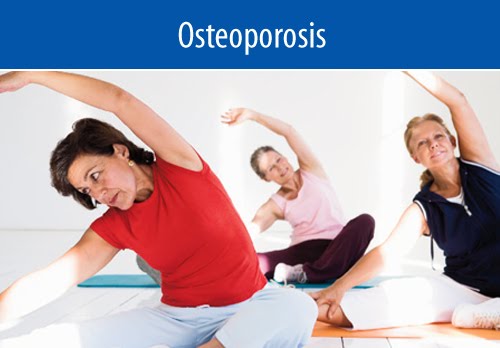
If you have ever wondered why so many elderly people seem to be stooped over and unable to stand up straight, the answer is osteoporosis, a condition in which bones become fragile and break easily. A series of small fractures and compressions in the bones of the spine causes the spine to curve into an “S” shape that makes the person bend forward.
It’s normal to lose some bone material. In fact, throughout our lives our bodies go through a continuing process of losing old bone and making new bone material to replace it. When we are young, the amount of bone material the body makes is greater than the amount it loses, and bone mass (the total amount of bone material in our bodies) increases. In early adulthood the process tends to reach a balance, and our bodies only replace what we actually lose, stabilizing our bone mass. Later, we begin to lose bone faster than we replace it. Over time, this can lead to weaker bones, a condition known as osteoporosis.
As we lose bone mass, all of our bones become fragile, not just the bones in our spine, and they fracture more easily. In fact, in someone with severe osteoporosis, something as simple as a strong hug can break a bone.
A Special Problem for Women
Even though anyone can develop osteoporosis, it occurs far more often in women. There are a number of reasons for this. To begin with, a woman’s bones are generally smaller and lighter than a man’s, so there is less bone mass to lose. Also, men reach their level of peak bone mass later than women, so they have more bone material when they enter the stage when their bone mass stabilizes. And when women go through menopause, their bodies stop making the hormone estrogen, and estrogen plays an important role in preventing bone loss.
In addition to being a woman, there are other factors that increase a person’s risk of osteoporosis. You are more likely to develop it if you are Asian or Caucasian (especially if you are fair-skinned); if you have a small, thin build; or if you have a family history of osteoporosis. Beginning menopause before the age of 45 (either naturally or as the result of having your ovaries removed surgically) also increases risk.
Some lifestyle factors also increase your chances of getting osteoporosis. These include: not getting enough exercise, smoking, consuming too much alcohol or caffeine, and not getting enough calcium. In addition, having certain medical conditions may make you more susceptible to osteoporosis, including diabetes, hyperthyroidism, and anorexia. Taking certain medicines—such as the steroids used to treat asthma and arthritis, certain anticonvulsants, some diuretics, and medicines that contain aluminum—also increases your chances of developing the condition. Taking too high a dose of a prescribed thyroid hormone is another contributing factor. If you aren’t sure if the medicines you take increase your risk, ask your London Drugs pharmacist.
The Telltale Signs
It is unfortunate, but osteoporosis does not announce its appearance with early warning signs. By the time you experience symptoms, your bones will already have become fragile. Once osteoporosis has become advanced, you may notice that you seem to be getting shorter or that your stomach seems to be sticking out. Eventually you may notice that you are developing a stooped posture and a hump may appear on the back just below the neck.
There are some tests that can detect osteoporosis in its early stages. A quick, painless bone density test can detect bone loss long before it would show up on a regular x-ray. And when this test is repeated over time, your doctor can track your rate of bone loss. A woman should have a bone density test performed if she is at least 65 years of age, had a fragility fracture after age 40, has a family history of osteoporosis, or has been on long-term steroid therapy. Future tests can be compared with this reading to help detect bone loss when it occurs.
There are some simple things you can do to reduce your risk of developing osteoporosis or to slow its progress if you catch it in the early stages. These include:
- Making sure you get enough calcium by eating a healthy, balanced diet. Good sources of calcium include dairy products, nuts, some seafood, and some green vegetables.
- Being physically active. Exercises such as walking and low-impact aerobics can help bones stay healthy. Check with your doctor before beginning any exercise program.
- Not smoking.
- Limiting the amount of alcohol and caffeine you consume.
Living with Osteoporosis
The treatment for osteoporosis involves a combination of healthy lifestyle changes that emphasize diet, exercise, and calcium supplementation. There are medicines available that can help slow down your rate of bone loss and even help replace lost bone. For women who have gone through menopause, hormone replacement therapy (HRT) may be helpful; however, this treatment is not right for every woman. In fact, there are some women who definitely should not be on HRT. You fall into this category if you have ever had breast cancer or cancer involving your reproductive organs, or if you have a blood clotting disorder. Other medications are available as well, and the choice of treatment is an individual one each woman must make
in consultation with her doctor.
If you have osteoporosis, it is important to do everything you can to prevent falls, because falling will lead to broken bones and immobility. Here are some tips that may help:
- Use a shower stall instead of a bathtub when you have a choice—or equip your bathtub with handrails and be very careful when stepping into or out of the tub.
- Use handrails whenever they are available in public places such as on stairs or along hallways.
- Make sure your home is well lit and your walkways are uncluttered.
- Use elevators instead of stairs or escalators when you have a choice.
- Wear comfortable shoes that are easy to walk in and stay securely on your feet.
- Don’t climb on chairs or ladders. If you need help in reaching something, ask someone for assistance.
- Squat down to pick things up from the floor rather than stooping or bending over, and never try to lift heavy things.
- When possible, avoid medicines that affect your balance. Your London Drugs pharmacist can tell you whether the medicines you take may have this side effect. If so, there may be another medicine your doctor can prescribe instead.
If you have any questions about osteoporosis or treatments for the condition, please come by the pharmacy and ask your London Drugs pharmacist.




